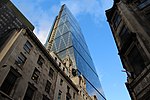100 Leadenhall
100 Leadenhall, nicknamed The Diamond, is a mixed-use development approved for the City of London. Designed by Skidmore, Owings & Merrill, the tower will be the financial district's third-tallest building upon completion. The wedge-shaped building will have a facade of elongated diamond shapes.A spokesperson from St Paul's Cathedral said that the tower would have a "harmful impact" on the protected views of the cathedral, and a statement from the Tower of London expressed concern at the skyscraper's diminution of the "visual dominance" of the historic site. The City of London's planning and transportation committee voted 22–2 in favour of the 100 Leadenhall build in July 2018.The development will include a free public viewing gallery, a restaurant, a bar and shops.
Excerpt from the Wikipedia article 100 Leadenhall (License: CC BY-SA 3.0, Authors).100 Leadenhall
Leadenhall Street, City of London
Geographical coordinates (GPS) Address Nearby Places Show on map
Geographical coordinates (GPS)
| Latitude | Longitude |
|---|---|
| N 51.5137 ° | E -0.0801 ° |
Address
Leadenhall Street 100
EC3A 4AA City of London
England, United Kingdom
Open on Google Maps




